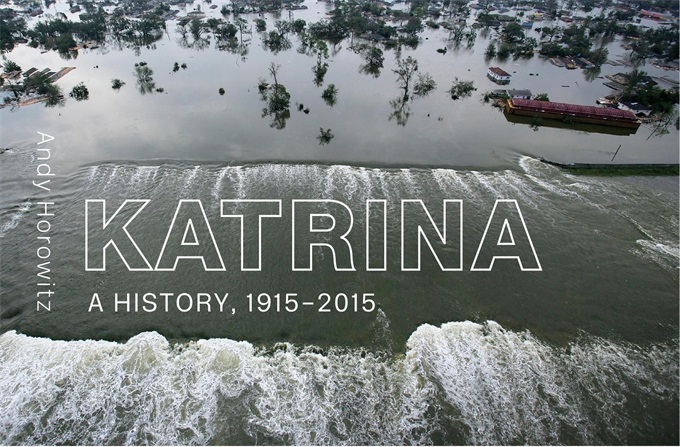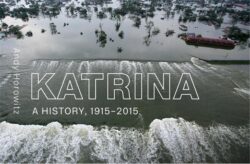Spring 2021
Defining a Disaster a Century in the Making
Historian Andy Horowitz looks back to understand Louisiana’s most devastating storm
Published: February 28, 2021
Last Updated: June 9, 2023

Harvard University Press
The 2021 Humanities Book of the Year is Katrina: A History, 1915–2015, by historian Andy Horowitz. In this in-depth look at one of America’s most destructive disasters, Horowitz finds the seeds of Hurricane Katrina and its aftermath nurtured over the course of the preceding century.
The following excerpt from Katrina: A History is reprinted with the permission of Harvard University Press. All rights reserved.
On September 19, 1915, at the muddy end of the Mississippi’s farthest reach into the Gulf of Mexico, one hundred miles downriver from New Orleans, an unnamed hurricane made landfall. An anemometer recorded wind gusts of 140 miles per hour there, at the town of Burrwood, Louisiana, where on easier days several hundred members of the Army Corps of Engineers lived in orderly cottages and worked to keep the shipping canal at the river’s mouth clear of sediment. As the storm moved upriver, the aneroid barometer at Tulane University plummeted to 28.10 inches. The rain gauge filled with 8.36 inches of precipitation in twenty-one hours. Even in a region accustomed to hurricanes, these were extraordinary measurements. Isaac Cline, the chief meteorologist at the United States Weather Bureau in New Orleans, reported that the storm was “the most intense hurricane of which we have record in the history of the Mexican Gulf coast, and probably in the United States.”
But meteorology is not meaning. On their own, these data reveal little about how the storm might have mattered to people, or how they might have responded to it. These precise metrics of wind speed, rainfall, and barometric pressure do not trace the shape of life in places that seem, repeatedly, to come under assault from the forces of nature. We need different tools to gauge those times when coincidences of earth, wind, and water upset the course of human events in ways so overwhelming that we name them with a word whose basic meaning suggests that the entire universe is out of joint: disaster.
Consider that during the 1915 hurricane, across the state of Louisiana, 275 people died. Property damage estimates ran to $12 million ($280 million in 2015 dollars). Upriver from Burrwood, only four houses remained standing in the town called Empire. East of New Orleans, in St. Bernard Parish, the settlement of Saint Malo was washed from the map entirely. That village bore the name of Jean Saint Malo, who in the 1780s had led a group of Africans trying to escape from slavery. Eventually captured by Spanish authorities, Saint Malo was executed in 1784 in front of the Cabildo, in the historic center square of New Orleans—where the hurricane winds had sent pieces of slate flying from the steeple of Saint Louis Cathedral. A foot of water remained in parts of the city for five days. Nonetheless, once the storm passed, many New Orleanians celebrated.
“‘Storm proof!’ The Record Shows Orleans,” the newspaper proclaimed after the hurricane. The mayor quickly rejected outside offers of aid. Surveying the event a month later, the New Orleans Sewerage and Water Board, the agency charged with protecting the city from floods, concluded that its new drainage system had passed a defining test. “It is safe to say,” its report asserted, “that no city anywhere in the world could have withstood these conditions with less damage and less inconvenience than has New Orleans.” Marshaling statistics from meteorologists like Isaac Cline, the report reasoned that the recent extreme occurrence of wind and rain “renders more remote the probability of a repetition of any of these things in the early future.”
…most houses built before 1915 did not flood, but most houses built after the Sewerage and Water Board’s 1915 call for further growth did.
It was a curious logic in a city that had seen ninety-two hurricanes or tropical storms since its European colonial founding in 1718. Despite this history, the Sewerage and Water Board believed that even if another big storm came, New Orleans would be safe. The report’s authors reflected on the storm’s “lessons” this way: “there is no reason why this city and its surrounding country should not continue, even more successfully than heretofore, [its] developments in all directions.” The experience of the 1915 hurricane affirmed the consensus among engineers and investors, city planners and politicians, home builders and home buyers, that New Orleans should grow.
The city they created became one of the most celebrated places in the world. “Ain’t no city like the one I’m from!” the women in the Original Pinettes Brass Band sang a century later. New Orleans’s admirers lauded it as “The Land of Dreams,” “The Big Easy,” “The City that Care Forgot,” “America’s Most Interesting City,” and “the soul of America.” With its jazz, Mardi Gras, and other iconic contributions to world culture, more than any other place in America, New Orleans called to mind creativity, cosmopolitanism, and love of life.
But today, New Orleans also calls to mind catastrophe. The city drowned when its levee system collapsed on August 29, 2005, killing hundreds of people, destroying thousands of homes, and precipitating not only one of the most horrific moments in modern American history, but offering an emblem for the idea of disaster itself: Katrina. The response to the 1915 storm thus cast a century-long shadow, because the new neighborhoods developed after that storm experienced the worst flooding in 2005. More than any other single factor, including the race or class of its inhabitants, the age of a building best predicted how it would fare in 2005. Tracing the outline of the Katrina flood reveals the shape of New Orleans as it stood nine decades earlier: most houses built before 1915 did not flood, but most houses built after the Sewerage and Water Board’s 1915 call for further growth did.
Usually, we imagine disasters as exceptions. We describe them as external attacks, ahistorical acts of God, blows from without. That is why most accounts of Katrina begin when the levees broke and conclude not long after. But these stories offer a denuded sense of what happened, why, or what might have prevented the catastrophe. Somebody had to build the levees before they could break.
I begin the story of Katrina in 1915 in order to pursue a different idea: that disasters come from within. Disasters are less discrete events than they are contingent processes. Seemingly acute incidents, like the largely forgotten 1915 hurricane, live on as the lessons they teach, the decisions they prompt, and the accommodations they oblige. Their causes and consequences stretch across much longer periods of time and space than we commonly imagine. Seeing disasters in history, and as history, demonstrates that the places we live, and the disasters that imperil them, are at once artifacts of state policy, cultural imagination, economic order, and environmental possibility.
Katrina’s causes and consequences reach across a century. The 1915 Sewerage and Water Board report shaped the rationale for developing the neighborhoods that flooded in 2005. Wrangling over fur trapping rights in the 1920s in St. Bernard Parish shaped the legal struggle for offshore oil in the 1940s, which shaped Louisiana’s economy in the 1950s, the state’s coastline in the 1970s, and the state’s Coastal Master Plan to confront land loss in the 2010s. When the Industrial Canal, dredged for shipping interests in 1918, flooded the homes of veterans during Hurricane Betsy in 1965, the memory of sharecropping shaped how African Americans interpreted the Small Business Administration loans they were offered as disaster relief. The memory of Hurricane Betsy shaped how New Orleanians responded when the Industrial Canal broke again under the weight of Hurricane Katrina’s storm surge in 2005. The promise of the federal Housing Act of 1937 shaped the claims that residents made for a right of return to public housing in 2007. The Louisiana state engineers dynamited a levee in St. Bernard Parish in 1927, which shaped fears in 1965 and 2005 that politicians had lit another fuse. The mutual benefit associations African Americans developed during Reconstruction to provide burial insurance shaped the Social Aid and Pleasure Clubs that offered Louisiana its most popular metaphor for recovery: the jazz funeral. When Jesse Jackson declared in 2005 that, filled with stranded African American Katrina victims, New Orleans’s Convention Center looked “like the hull of a slave ship,” he was admonishing all who heard him that disasters offer no escape from the past.
And yet, if understanding history usually demands drawing connections between seemingly disparate dots, trying to make sense of what happened in Louisiana after August 29, 2005, also poses the opposite problem, because the hurricane called Katrina did not cause many of the effects commonly attributed to it.
After the storm passed, New Orleans police officers shot and killed unarmed citizens. The Federal Emergency Management Agency gave flood victims trailers laced with formaldehyde. The New Orleans City Council voted to demolish the city’s public housing apartments. The Louisiana State Legislature voted to transform the city’s public school system into a confederacy of charter schools. Congress voted to fund the largest housing recovery program in United States history; the program appropriated money to homeowners but not to renters. New Orleans police officers arrested musicians for leading jazz funerals without permits, while violent crime plagued the city. Louisiana State University shut down New Orleans’s public Charity Hospital, while rates of mental illness surged. The Army Corps of Engineers encircled the city with a new levee system, while the wetlands beyond the walls continued to erode and the city itself continued to sink. A decade after the storm, New Orleans’s population had fallen from 484,674 to 390,711. Of the people missing, the vast majority—nearly 92,000 people—were African American. We have come to refer to this sequence of events as “Katrina,” but for none of these effects was the hurricane the proximate cause.
